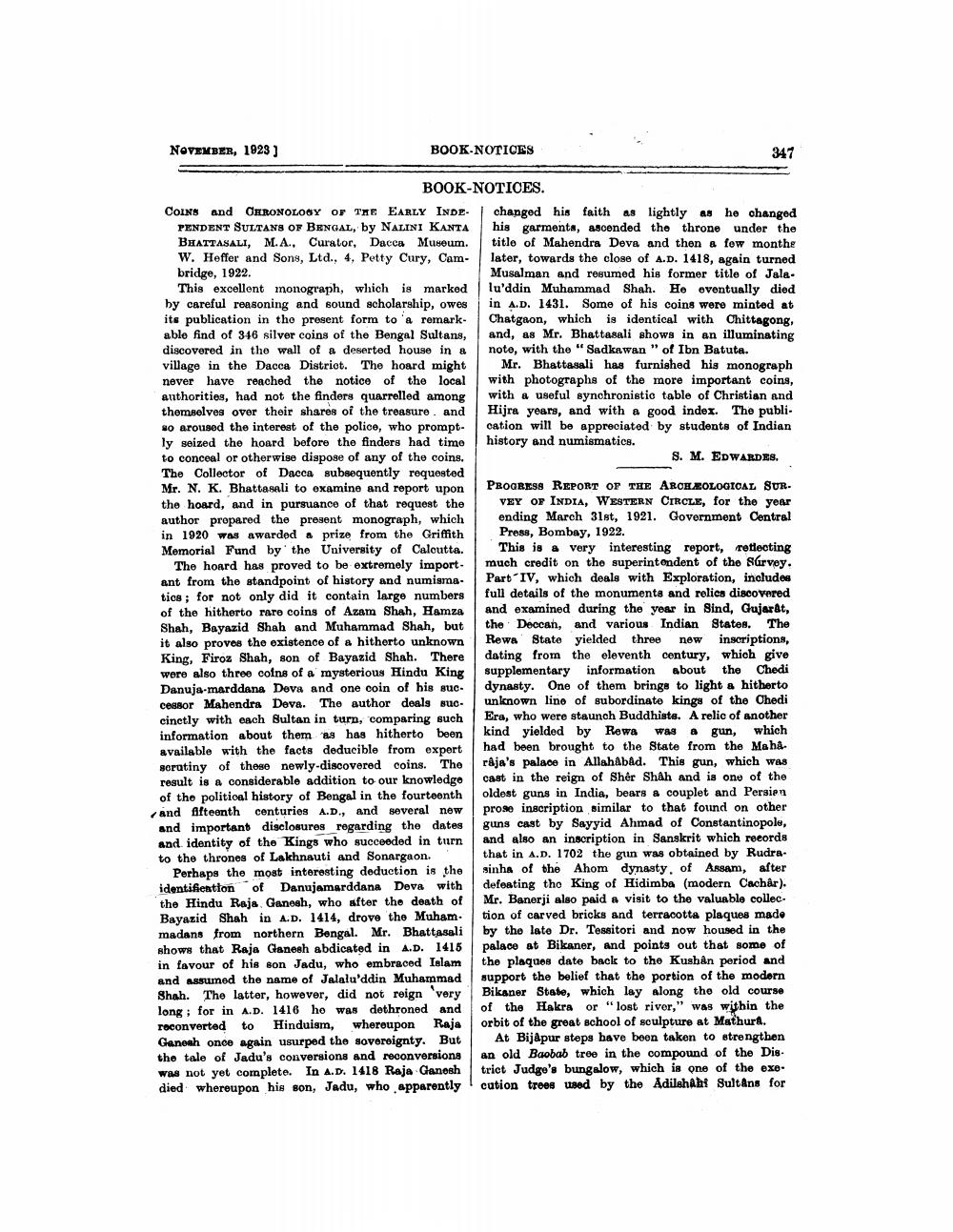________________
NOVEMBER, 1923 ]
BOOK-NOTICES
BOOK-NOTICES.
COINS and CHRONOLOGY OF THE EARLY INDEPENDENT SULTANS OF BENGAL, by NALINI KANTA BHATTASALI, M.A., Curator, Dacca Museum. W. Heffer and Sons, Ltd., 4, Petty Cury, Cambridge, 1922.
This excellent monograph, which is marked by careful reasoning and sound scholarship, owes its publication in the present form to a remarkable find of 346 silver coins of the Bengal Sultans, discovered in the wall of a deserted house in a village in the Dacca District. The hoard might never have reached the notice of the local authorities, had not the finders quarrelled among themselves over their shares of the treasure and so aroused the interest of the police, who promptly seized the hoard before the finders had time to conceal or otherwise dispose of any of the coins. The Collector of Dacca subsequently requested Mr. N. K. Bhattasali to examine and report upon the hoard, and in pursuance of that request the author prepared the present monograph, which in 1920 was awarded a prize from the Griffith Memorial Fund by the University of Calcutta.
The hoard has proved to be extremely important from the standpoint of history and numismatics; for not only did it contain large numbers of the hitherto rare coins of Azam Shah, Hamza Shah, Bayazid Shah and Muhammad Shah, but it also proves the existence of a hitherto unknown King, Firoz Shah, son of Bayazid Shah. There were also three coins of a mysterious Hindu King Danuja-marddana Deva and one coin of his successor Mahendra Deva. The author deals succinctly with each Sultan in turn, comparing such information about them as has hitherto been available with the facts deducible from expert scrutiny of these newly-discovered coins. The result is a considerable addition to our knowledge of the political history of Bengal in the fourteenth and fifteenth centuries A.D., and several new and important disclosures regarding the dates and identity of the Kings who succeeded in turn to the thrones of Lakhnauti and Sonargaon.
Perhaps the most interesting deduction is the identification of Danujamarddana Deva with the Hindu Raja Ganesh, who after the death of Bayazid Shah in A.D. 1414, drove the Muham. madans from northern Bengal. Mr. Bhattasali shows that Raja Ganesh abdicated in A.D. 1415 in favour of his son Jadu, who embraced Islam and assumed the name of Jalalu'ddin Muhammad Shah. The latter, however, did not reign 'very long; for in A.D. 1416 he was dethroned and reconverted to Hinduism, whereupon Raja Ganesh once again usurped the sovereignty. But the tale of Jadu's conversions and reconversions was not yet complete. In A.D. 1418 Raja Ganesh died whereupon his son, Jadu, who apparently
347
changed his faith as lightly as he changed his garments, ascended the throne under the title of Mahendra Deva and then a few months later, towards the close of A.D. 1418, again turned Musalman and resumed his former title of Jalalu'ddin Muhammad Shah. He eventually died in A.D. 1431. Some of his coins were minted at Chatgaon, which is identical with Chittagong, and, as Mr. Bhattasali shows in an illuminating note, with the "Sadkawan " of Ibn Batuta.
Mr. Bhattasali has furnished his monograph with photographs of the more important coins, with a useful synchronistic table of Christian and Hijra years, and with a good index. The publi cation will be appreciated by students of Indian history and numismatics.
S. M. EDWARDES.
PROGRESS REPORT OF THE ARCHEOLOGICAL SURVEY OF INDIA, WESTERN CIRCLE, for the year ending March 31st, 1921. Government Central Press, Bombay, 1922.
a
This is a very interesting report, reflecting much credit on the superintendent of the Survey. Part IV, which deals with Exploration, includes full details of the monuments and relics discovered and examined during the year in Sind, Gujarat, the Deccan, and various Indian States. The Rewa State yielded three new inscriptions, dating from the eleventh century, which give supplementary information. about the Chedi dynasty. One of them brings to light a hitherto unknown line of subordinate kings of the Chedi Era, who were staunch Buddhists. A relic of another was kind yielded by Rewa gun, which had been brought to the State from the Maharaja's palace in Allahâbâd. This gun, which was cast in the reign of Sher Shah and is one of the oldest guns in India, bears a couplet and Persien prose inscription similar to that found on other guns cast by Sayyid Ahmad of Constantinopole, and also an inscription in Sanskrit which records that in A.D. 1702 the gun was obtained by Rudrasinha of the Ahom dynasty, of Assam, after defeating the King of Hidimba (modern Cachar). Mr. Banerji also paid a visit to the valuable collection of carved bricks and terracotta plaques made by the late Dr. Tessitori and now housed in the palace at Bikaner, and points out that some of the plaques date back to the Kushân period and support the belief that the portion of the modern Bikaner State, which lay along the old course of the Hakra or "lost river," was within the orbit of the great school of sculpture at Mathura.
At Bijapur steps have been taken to strengthen an old Baobab tree in the compound of the Dis. trict Judge's bungalow, which is one of the execution trees used by the Adilshah Sultans for




